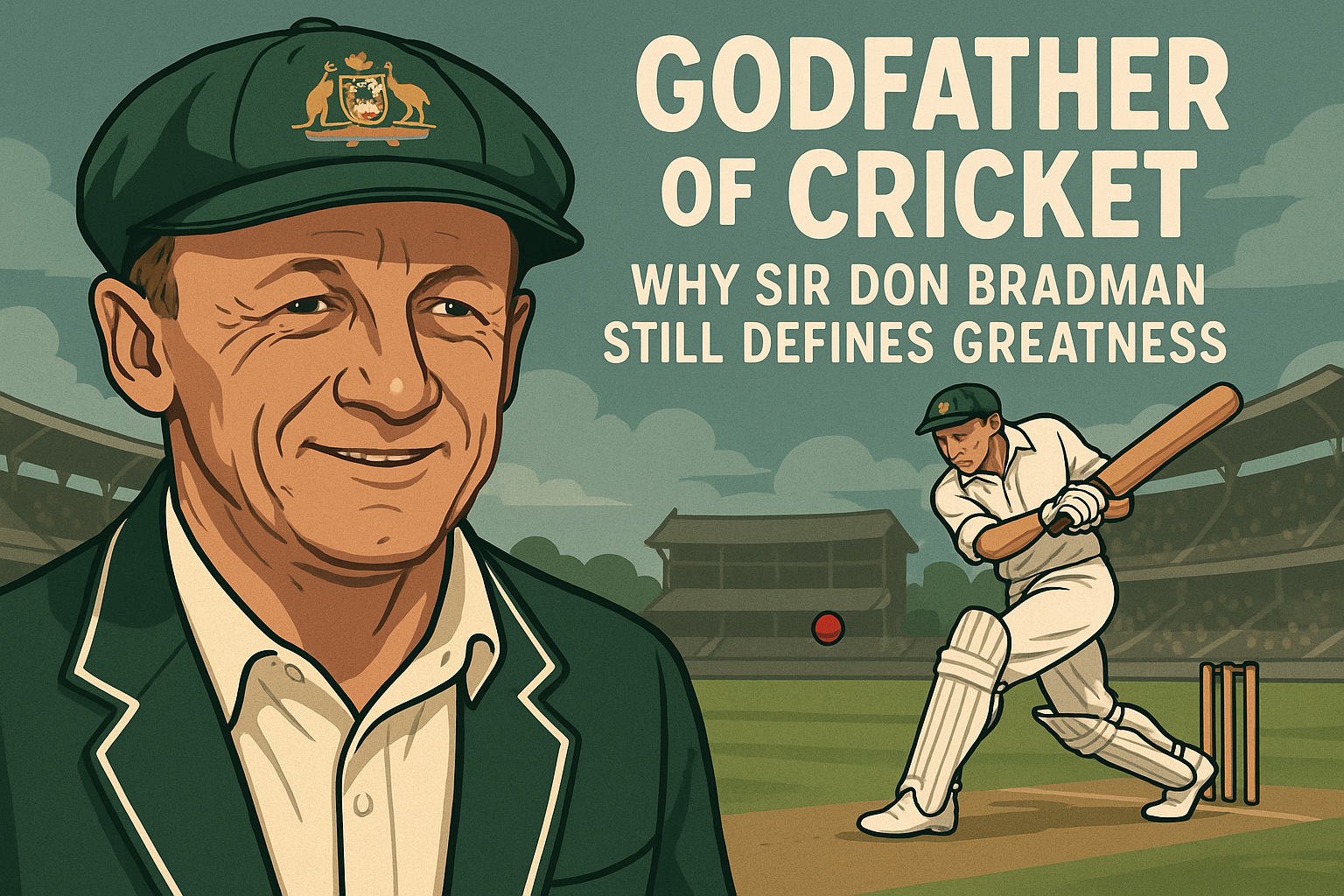Cricket is a game of elegance and grit. Of silence between deliveries and mayhem between overs. The arc of a willow carving through time and tradition has created legends. But among all those monumental figures, one name consistently echoes through cricketing lore — Sir Donald George Bradman. Referred to with reverence and often simply as “The Don,” he stands as the undebatable bearer of a heavyweight title: the Godfather of Cricket.
This isn’t just about record books, though they yield to his supremacy. This isn’t merely nostalgic affection or colonial bias. It’s about what Bradman symbolized and how he redefined the trajectory of the sport — tactically, statistically, emotionally, and globally.
In this deep dive, we go well beyond stats and dig into what makes Sir Don Bradman merit that rarefied title. We’ll explore the history of cricket icons, compare him with other greats, unravel famous monikers in cricket, and examine why “Godfather” fits Bradman better than any other legend in the game.
Table of Contents
- What Does ‘Godfather of Cricket’ Even Mean?
- The Making of a Legend: Who Was Sir Don Bradman?
- Cricket Before Bradman: A Game in Flux
- Bradman’s Numbers: More Than Just a Batting Average
- Why Is Sir Don Bradman Called the Godfather of Cricket?
- Godfather vs. King of Cricket: Titles that Define Eras
- Bradman vs Sachin: The Eternal Debate
- Cricketing Titles and What They Say About a Player
- Influence Beyond the Boundary: Bradman the Myth-Buster
- Key Takeaways: What Bradman Gave the Game
- Final Thoughts: The Godfather Doesn’t Fade
What Does ‘Godfather of Cricket’ Even Mean?
Titles in cricket aren’t handed out lightly. You earn them over decades — through stump-breaking spells, genre-defining innings, or longevity that reimagines the word ‘dominance.’ But ‘Godfather’ carries its own unique weight.
The term isn’t just about being first, or even the best statistically. It connotes origination, authority, legacy, and something closer to fatherhood over the game. Unlike “King of Cricket” or “Master Blaster,” the Godfather is a title with governance. A figure whose presence reshapes everything after him.
When people search who is the Godfather of Cricket, the answer comes almost involuntarily from seasoned journalists, ex-players, and cricket historians: Sir Don Bradman. But why?
The Making of a Legend: Who Was Sir Don Bradman?
Don Bradman was a wiry kid from Bowral who first fine-tuned his reflexes by bouncing a golf ball off a water tank with a stump. That self-invented drill would later become the metaphor for his genius: a solution to a problem nobody else knew existed.
He debuted in an era when cricket was largely British and conservatively tactical. What Bradman injected into the bloodstream of the sport was urgency, unpredictability, and perhaps most importantly — a system of destruction within discipline.
Bradman’s story was not draped in privilege or elite schooling. He was a bush boy turned revolutionary. His scripts weren’t scribbled by men in committees. He wrote them in centuries, session after session.
Cricket Before Bradman: A Game in Flux
To understand why Bradman’s influence was seismic, you need to peer into what cricket looked like before him.
- Matches were slow, often dragged across timeless formats.
- Batting averages, even among the elite, rarely flirted above the 50 mark.
- The mental attitude was defensive-first: protect your wicket long enough to wear bowlers down.
Bradman flipped all of that. He didn’t just survive the opposition — he obliterated it.
This is what makes his title as the Godfather of Cricket meaningful. He didn’t improve a system — he reinvented it. His surge of scoring inspired not just fans but forced selectors, coaches, and captains to rethink how attacks should be built and games won.
Bradman’s Numbers: More Than Just a Batting Average
Let’s not pretend the stats aren’t part of the legend.
| Metric | Don Bradman | Nearest Modern Equivalent |
|---|---|---|
| Test Batting Average | 99.94 | ~60 (Sachin, Kallis, Smith) |
| Number of Double Centuries | 12 (in fewer matches) | 6–7 (from 150+ matches) |
| Century Conversion Rate | Every 2.75 innings | Around 6–8 innings |
| Test Matches Played | Under 60 | Most greats played 120+ |
His performance cannot be equated by numbers alone. The match circumstances, pitch conditions, opponents, lack of protective gear — all weigh in heavily and favor Bradman’s era making his dominance even more astonishing.
Why Is Sir Don Bradman Called the Godfather of Cricket?
Here’s the short answer: because he created the blueprint for cricketing greatness.
But the long answer is more textured.
Tactical Genius
What separated Bradman wasn’t just clean striking — it was how he read the psychology of opponents. He understood momentum before it was modeled. Bowlers who tried to bounce him found their spells repurposed into theatre for his strokeplay. Those who contained him were dismantled by angular cuts and midnight drives.
Psychological Warfare
The infamous Bodyline series wasn’t just a dark chapter — it was a testimony to his threat. England had to re-write their ethics just to encage him, proving his sheer gravitational impact.
Rebellious Technique
Bradman’s grip was unconventional. His backlift wasn’t textbook. By current coaching manuals, he broke rules. And that’s exactly what gave him an edge — his reflex arcs and muscle memory operated on a private frequency few bowlers ever decoded.
Cultural Icon
In the shadows of war and recession, Bradman offered something intangible — hope. He wasn’t a player; he was a metaphor. When runs were scarce and spirits lower, a Bradman ton felt like resistance against despair.
Godfather vs. King of Cricket: Titles That Define Eras
Some call Kohli the King of Cricket. Others labeled Tendulkar as the Master Blaster or Little Master. MS Dhoni? The Captain Cool. Brian Lara? The Prince.
But Bradman? His name isn’t decorated with flair — it resounds with gravity. That’s the distinction of Godfather over King. A king rules; a godfather builds the kingdom.
These aren’t theoretical embellishments. They define the impact tier players belong to. Godfathers change DNA; kings dominate existing systems.
Bradman vs Sachin: The Eternal Debate
Let’s address the elephant in every global cricketing room.
Comparisons between Bradman and Tendulkar breed as many opinions as Delhi summers breed sweat. But look at them dimensionally.
| Category | Bradman | Tendulkar |
|---|---|---|
| Batting Average | 99.94 | 53.78 |
| Matches | < 60 Tests | 200 Tests |
| Conversion Rate | Insane | Great |
| Contextual Pressure | Existential (economic/political) | Commercial/media-driven |
| Influence on the Game | Evolutionary | Inspirational |
Bradman reinvented the game structurally. Sachin — through longevity and consistency — expanded its reach emotionally. One built code, the other scaled users.
And even Tendulkar, in perhaps his most revealing moment, once said, ‘I saw myself in Bradman’s eyes.’
Cricketing Titles and What They Say About a Player
Nicknames in cricket are rarely just illustrations — they’re storied identities. Here’s how they stack up:
| Title | Player | Why It Matters |
|---|---|---|
| Godfather | Don Bradman | Architect of batting dominion |
| King | Virat Kohli | Present-day dominance across formats |
| Prince | Brian Lara | Strokes of elegance and risk |
| Master Blaster | Sachin Tendulkar | Modesty meeting unmatched stats |
| Captain Cool | MS Dhoni | Strategy with icy nerves under fire |
What separates Bradman’s title is its timeless core. Others describe form or fashion. Godfather describes essence.
Influence Beyond the Boundary: Bradman the Myth-Buster
It’s hard to grasp how deeply Bradman infiltrated the sports culture of his time. He wasn’t just Australia’s national treasure; he was cricket’s ideological spearhead.
- He was the reason cricket matches became mass spectacles.
- He inspired mental conditioning decades ahead of its time.
- He made batsmen think like tacticians.
- He made bowlers think twice.
His role post-retirement — as a selector, a writer, a voice of reason — continued until his twilight years. Even then, he refused honorary knighthood till after crossing milestones, not before — classic Godfather humility.
Key Takeaways: What Bradman Gave the Game
- A new standard: 99.94 became not just a statistic, but a boundary of perfection.
- Bodyline as a response: No other player triggered tactical structural change globally.
- Style of play: Setting the tone for aggressive yet thoughtful batting.
- Emotional anchor: Became Australia’s rally point in dry decades.
- Philosophical framework: Inspired players to see cricket as art as much as sport.
Final Thoughts: The Godfather Doesn’t Fade
In cricket, as in life, influence isn’t always measured in real time. But as generations pass, and as greats rise and fall, the outline of Don Bradman looms fresher, crisper.
That’s the mark of a Godfather.
Not the loudest. Not the flashiest.
But the foundational force that future greatness builds upon.
So, when people ask Who is the Godfather of Cricket, know that the answer isn’t just from pages of scorecards or ESPN specials. It’s from pitch cracks in Adelaide that whispered in awe. It’s in tales from coaches who never saw him but shaped their drills imagining him. It’s in the way a thousand kids today still tap a ball against a wall, lost in dream.
Sir Don Bradman — cricketer, tactician, legend, legacy — the Godfather of Cricket. And he always will be.
Writers who haven’t played the game often miss the silences between overs. Bradman didn’t. That’s how you know he wasn’t just playing cricket — he was curating its future.

Zahir, the prolific author behind the cricket match predictions blog on our article site, is a seasoned cricket enthusiast and a seasoned sports analyst with an unwavering passion for the game. With a deep understanding of cricketing statistics, player dynamics, and match strategies, Zahir has honed his expertise over years of following the sport closely.
His insightful articles are not only a testament to his knowledge but also a valuable resource for cricket fans and bettors seeking informed predictions and analysis. Zahir’s commitment to delivering accurate forecasts and engaging content makes him an indispensable contributor to our platform, keeping readers well informed and entertained throughout the cricketing season.



